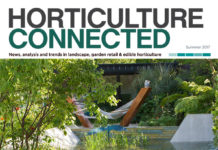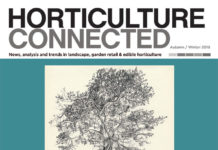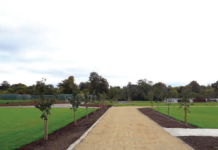Mary Forrest, Professor at UCD School of Agriculture and Food Science, provides a fascinating insight into the trees and shrubs of Denmark, many of which could be effectively used in the Irish landscape
Denmark and Sweden are seldom visited for their gardens, parks and open spaces, at least by Irish horticulturists. A tour with the International Dendrology Society to Denmark and southern Sweden in June 2017 was an eye-opener to the wealth of trees and shrubs cultivated. While the landscape elements in suburban gardens, parks and open spaces are similar to this country, many of the trees, shrubs, climbers and hedges cultivated are unfamiliar or cultivated dierently. They provide new ideas for the design and management of planting schemes in Ireland.
SOME TREES WORTH PLANTING
Zelcova serrata, a relative of Ulmus (elm), is a well-branched wide spreading, smooth-barked tree to 20m with finely pointed ovate foliage and good autumn colour. More elegant that Carpinus betulus ‘Fastigiata’ (hornbeam), it is suitable for space where Fagus (beech) would become too large a tree.
Cercidiphyllum japonicum f. pendulum is a weeping graceful tree, less angular than Fraxinus excelsior ‘Pendula’ (weeping ash). The leaves are opposite and round. Each spring the emerging amber coloured young foliage permeates the air with a sweet scent, this colourful display is repeated in the autumn.
As in Ireland, Japanese maples (Acer palmatum) were popular in suburban gardens and in tree collections. Their cultivation as a hedge is unusual but eective since when not in leaf, many-branched stems continue to act as a screen (Fig 1). Many other small to medium-sized maple species were cultivated; Acer carpinifolium, as the name indicates has hornbeam-like (Carpinus) foliage, produces plenty of seed; A.trautvetteri is a beautiful fast growing tree with seeds which become an attractive red colour, and A. sempervirens is a neat tree with the typical three-lobed leaves of maple foliage, stiff to the touch and distinctly parallel sided seed.
Although Liquidambar styraciflua (liquidambar) is growing well as a street tree in Dublin, providing rich autumn colour, it flowers in Copenhagen. Clusters of female flowers, green ones from this year and reddish from last year hung beneath the maple-like foliage.
While birch is native in Nordic countries species from Manchuria, Japan and China trees were frequent in tree collections in Denmark and Sweden. Betula costata is a tall growing tree with ‘very’ peeling bark on the main trunk, less so on well-coloured branches. Betula ermanii has a pale coffee-coloured smooth bark on branches and upper part of the trunk. Betula davurica, again with a shaggy peeling bark, was planted in a few collections. Though in leaf the branch coloured and peeling papery nature of the bark was obvious, these trees growing as specimens or in groups must be spectacular in winter.
Ptelea trifoliata (hop tree) a deciduous wide-spreading tree was commonly planted in gardens and tree collections. In late June to July, it looks attractive from a distance with shiny trifoliate leaves and a ‘haze’ of white flowers. On closer inspection, they were clusters of dainty star-like flowers.
Gleditsea triacanthos ‘Rubylace’ is a small specimen tree. It was well placed by a flight of steps in a suburban garden where brown tinted bark and bronze coloured pinnate foliage could be admired from above and below. Flowers were the noticeable features of two other leguminous plants. Colutea arborescens (bladder senna) is a 1m tall deciduous shrub summer flowering shrub with pinnate leaves. The bright yellow pea-like flowers each with delicate orange markings are succeeded by pea-like seed pods which swell to what is commonly called a bladder. Indigofera amblyantha is an elegant tall shrub to 2m, with small pinnate leaves. Pale pink or mauve flowers are borne over a long flowering from June to October, a time when few shrubs are in flower. While both genera are grown in Irish plant collections they deserve wider use as summer-flowering shrubs in dry sunny situations.
SHRUBS AND CLIMBERS FOR LANDSCAPE SCHEMES
Viburnum tinus and V. davidii are stalwarts of landscape schemes in Ireland but other species are worth planting. Viburnum ‘Pragense’ is a medium sized shrub, a hybrid of V.
rhytidophyllum and V.utile. The foliage is evergreen, like a smaller version of V. rhytidophyllum but with glossy rather than matt foliage. Viburnum lentago is an attractive medium to large size shrub with mid-green shiny leaves. These Viburnum were grown to create an informal wall or barrier like shrubberies in a garden.
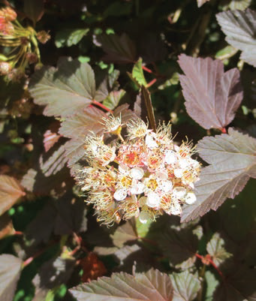
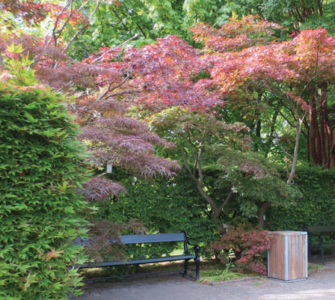

While Cotoneaster is common in Ireland, little was grown in Denmark, an exception being Cotoneaster salicifolius floccus. A shrub to 2m x 3m with narrow leaves shiny green above, woolly white beneath, it was wreathed in white flowers. An autumn display of berries would follow. Like Cotoneaster, Physocarpus opulifolius also gives good value in a landscape scheme. Though deciduous, the species has a neat dense habit, guelder rose-like foliage
(Viburnum opulus). White flowers, borne in round heads in June are succeeded by round seed heads of small inflated pods. Physocarpus ‘Diabolo’ with dark red foliage was very common in gardens. Other cultivars grown were P. ‘Dart’s Gold’ and P. ‘Amber Jubilee’ with amber bronze young foliage which then fades to green (Figure 2).
Kolkwitzia amabilis (Beauty Bush) is a very popular early summer flowering shrub in Danish town gardens. Its popularity is attributed to Aksel Olsen (1887 – 1982) who founded his nursery at Kolding, Denmark, in 1917 and made the shrub known to gardeners. When in flower it is laden with pink bell-shaped flowers, each with a yellow throat.
Lonicera involucrata is a shrub for large-scale planting in light woodland or in the open. It is a deciduous shrub to 2-3m or so, flowering over the summer months. Yellow tubular flowers sit in heart-shaped red bracts, an involucre, where black fruit later develops. It is the sort of shrub which could be severely pruned every few years and would then regenerate (Figure 3).
Lonicera henryana is an evergreen climber with long narrow dark green leaves. In Ireland, it can become rampant and is shy flowering. Perhaps as seen in Sweden it might develop more amber tinged red flowers when confined in a container. As in Ireland Hydrangea petiolaris, a deciduous white flowering climber was cultivated. In Denmark, it could scale the heights of tall trees and interestingly was also cultivated as an extensive groundcover plant.
Two species grown as groundcover plants provided substantial weed smother. Bugglossoides purpureocaerulea is a spreading ground cover suitable for a shaded situation beneath shrubs. The stems, with narrow elliptic leaves, rise to 50 – 60cm. The name is very descriptive, the flowers look like a tubular bugloss, the flower opens purple and becomes blue (purpureocaerulea). Asarum europaeum grows a couple of centimetres tall but its chief merits are a dense habit and glossy green, heart-shaped or kidney-shaped leaves. It grows well in shade, at the margins of tree and shrub planting. It is also grown in landscape schemes in the Netherlands.
Trifolium pannonicum, (Hungarian clover) is a neat upright plant to 78-80 cm, branched from the base, with narrow green leaves in threes, as in clover with white globular flower heads, typical of clover. The stems have sufficient strength so as not to warrant staking and therefore useful in low maintenance schemes. Trifolium trichocephalum grows to a similar height with similar erect stems, leaves fringed with hairs and pale yellow flowers.
LANDSCAPING IN TOWNS AND CITIES
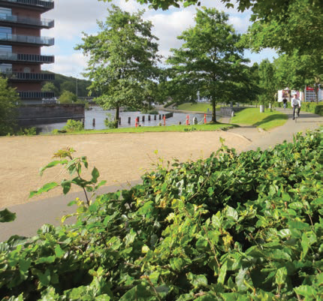

In the general landscaping of towns, larger growing trees such as Tilia (lime) and Quercus (oak) were planted. Taxus baccata (yew) was a common hedge. Fagus sylvatica (beech) was managed more as an extensive groundcover ‘laurel lawn’ and a low internal wall in a car park, rather than as tall hedges (Figure 4). Alnus incana ‘Imperialis’, a cut-leaved form of the grey alder, was coppiced and the resulting growth formed an attractive shrub. In Copenhagen Spiraea x bumalda and Symphoricarpos chenaultii ’Hancock’ were common groundcover shrubs, in leaf and flower in the summer and with a dense pattern of branches in the winter. Travelling through towns and suburbs, Acer campestre (field maple) grown as a hedge and Japanese maples (Acer palmatum) cultivated as garden trees were well favoured in private gardens.
Climbing roses were common in Copenhagen. A semi-circular ornate ‘rose’ guard, as opposed to a ‘tree guard’, was used against walls of houses, apartments and commercial buildings. The white flowering Rosa ‘New Dawn’ was recognisable, but red flowering climbers were also grown. In the southern Swedish seaside town of Ystad, town dwellers had planted climbing roses and tall hollyhocks in the pavements outside their homes. It was a surprise to see hollyhocks as they are associated with warmer climates. Considering the range of trees and shrubs plants observed in flower or fruit suggests that they benefit from a more continental climate with warmer summers and more hours of sunshine than are experienced in Ireland. We have looked to Mediterranean countries for new plants; perhaps we might also consider Nordic countries for resilient robust yet highly ornamental trees and shrubs.
The following gardens and parks, all open to the public are worth a detour: University of Copenhagen Botanical Garden, University of Copenhagen Horticultural Garden, Assistens Kirkegård city cemetery and King’s Garden (Rosenborg Garden) a Royal Park – all close to Copenhagen city centre. Gothenburg Botanic Garden – managed by the municipality and Trädgårdsföreingen – run by the Garden Society of Gothenburg. ✽
  |




